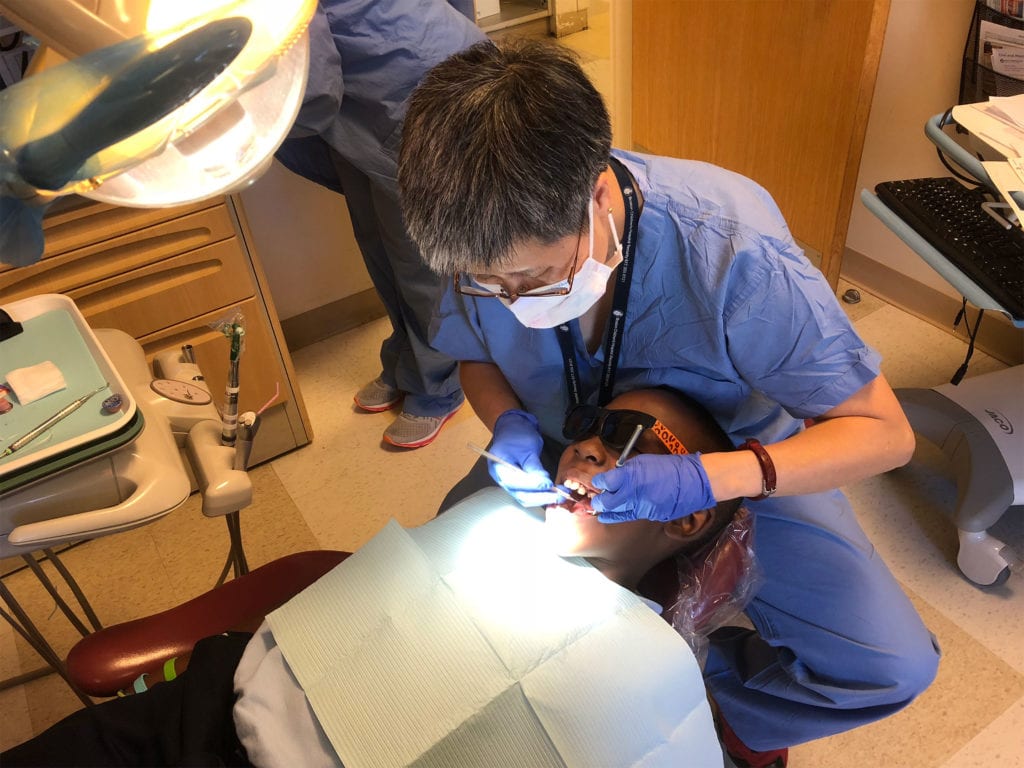
A BABY’S TOOTHLESS GRIN hides the 20 primary teeth lurking in the gums. They typically make their appearance within 33 months. These baby teeth have a lot of responsibility. They not only hold space in the jaw for permanent teeth, but also help to chew, speak and smile. They eventually move on to make way for their replacements. When all is said and done, each person has 32 permanent teeth … and they have to last a lifetime.
Unfortunately, most times they do not. Forty-three percent of youth between two and 19 have already experienced tooth decay, according to a recent report by the National Center for Health Statistics. Nine percent of kids between the ages of two and five have untreated cavities, and that percentage increases with age. The prevalence is highest among Hispanic youth and those of lower income. Yet, tooth decay is almost completely preventable.
One reason for poor dental health in children may be attributed to myths and misunderstandings. According to a survey sponsored by the Children’s Dental Health Project, at least 40 percent of the respondents did not realize that sugar in natural fruit juice can cause cavities in children. At least 40 percent believed that you shouldn’t start brushing a child’s teeth until the age of three.
Not so, explained Dr. Man Wai Ng, Dentist-in-Chief of the Department of Dentistry at Boston Children’s Hospital. Actually, dental care should start even before the first tooth appears. Plaque, that ubiquitous film of bacteria that invades everyone’s mouth, can build up on the gums. It’s recommended to wipe the baby’s gums with a moist washcloth after every meal. The cleaning not only prevents the buildup of plaque, but can also help infants develop a tolerance to oral care.

For children younger than three, the American Dental Association recommends limiting the amount of fluoride toothpaste to no more than the size of a grain of rice (left). For children three to six, use no more than a pea-sized amount of fluoride toothpaste (right). photo: American Dental Association
When the first tooth erupts, the washcloth is traded for a baby toothbrush with just a dab of fluoride toothpaste about the size of a grain of rice, recommends the American Dental Association. Brush twice a day. It’s best not to rinse out to help get the maximum benefit of fluoride. There’s no alarm if the baby swallows this tiny amount of fluoride. The scant amount should cause no harm. By age three the ADA advises increasing the fluoride toothpaste to the size of a pea.
Flossing is added to the routine when two teeth touch. String floss is not necessary. Flossers with handles are easier. Ng admits it’s a bit tricky to brush and floss, particularly the top front teeth and back teeth. Positioning is important. “Hold the baby from behind,” she advises. “Cradle the head on your belly and gently stretch out the lips.” Tooth brushing does not take long — about 30 seconds for infants. Brush along the gum lines as well. Parents should continue to brush their child’s teeth at least twice a day. By the age of seven or eight the child can brush the teeth by him or herself, but the parent must still supervise.
At a year, or no later than six months after the first tooth comes in, an infant should have the first visit to the dentist and establish a dental home. “Consider it a well-child visit,” she said. Visits are typically spaced six months apart, but more frequently if decay is already present.
Obstacles to preventive care
There are some things that parents do unwittingly that prove to be harmful to the child’s teeth. For instance, baby bottle tooth decay develops when babies are put to sleep with a bottle filled with milk, juice or other forms of sugar. The ADA recommends that babies finish their bottle prior to being put down for a nap or the evening or allow only water in the bottle.
Vertical transmission is another. That’s a technical term for the sharing of oral bacteria between mother and child. When a caregiver tastes or blows on food before feeding it to a child, or shares cups and utensils, those bad bacteria that cause tooth decay just stroll from one mouth to the other. The oral state of the mother is often reflected in the child, thus an incentive for her to take care of her teeth as well.The biggest obstacle to good oral health, however, is nutrition . Tooth decay forms when the bad bacteria in the mouth interacts with sugar, carbohydrates or starch. And children are no strangers to these foods — crackers, chips, cookies, candy, pizza and sugar-coated cereal. Even healthy sugars are to blame. The American Academy of Pediatrics recommends limiting 100 percent fruit juice to no more than four to six ounces a day for children between the ages of one and six. Actually the Academy now says no juice before the age of one. Whole fruit is preferred.
“That’s why we discourage frequent snacking of processed carbohydrates. Instead we recommend moving from carbohydrates to proteins,” explained Ng. Better choices are cheese, nuts and seeds that reduce the acids and raise the pH of the saliva in the mouth. Drink juice and milk only at meal times and encourage water other times.
A barrier to decay
Sealants are plastic coatings that are applied to the grooves of the permanent and sometimes primary molars that are prone to decay. The sealants prevent bacteria and food particles from attaching to the surface of the teeth, and may be re-applied if necessary.
Although 70 percent of residents in Massachusetts have access to fluoridated water, some parents have concerns about its safety for their children. Ng does not agree. Fluoride prevents tooth decay by making teeth stronger, she explained. It can even halt dental caries in its track. The first step of caries leaves a tell-tale white spot on the tooth. Fluoride can reverse such early tooth decay. In addition, dentists and pediatricians apply a fluoride varnish to teeth to prevent and control dental caries.
Persistent parents, however, sometimes resort to xylitol, a sugar substitute that helps reduce the development of cavities and plaque formation. It also increases the flow of saliva to help repair of damaged tooth enamel. Xylitol is found in many products, including toothpaste, chewing gum and mints. After snacking, if a toothbrush is not handy, older children and adults may chew xylitol and other sugar-free gum to clear away sugars and acids. Yet, xylitol does not trump daily brushing with fluoride toothpaste and flossing.
It may be possible to keep all 32 teeth free of decay, but you have to start from day one.






